Native Son – February, 2011
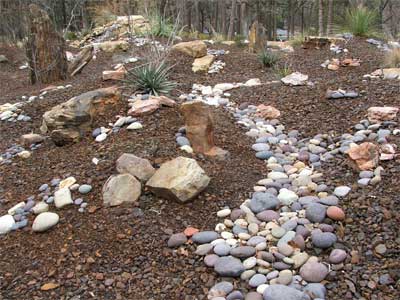
The dry garden, or “moonscape,” at the R. W. Norton Art Gallery in Shreveport. All photos by Steven Chamblee.
Road Trips to Austin-Shreveport
Life’s balancing forces, the Yin and Yang, become blatantly obvious during a Texas winter. One week I’m sliding sideways down the road on glare ice, leaning into a bone-numbing wind, and chuckling at the sight of dogs and cats huddled together to stay warm. Eight days later, birds are singing in the sunshine, sweat rolls down my brow, and I chuckle at the sight of my chalky white legs on the first shorts day of the year. The garden still shows the scars of the “Artic Blast” (remember when we called it a “Blue Norther?”), but inside our hearts, spring fever has already sprouted. Even I want to ignore the Sage Sperry as he says, “Not yet, my brothers and sisters of the soil, not quite yet!” The cuts on my arms from rose pruning have not even healed, and I’m already primed for new color, new surprises, new successes, and even the inevitable new failures that come along for the ride. How could we possibly appreciate spring if it didn’t follow winter?
I took two trips this month; the Yin was Austin, the Yang was Shreveport. Austin — dry, rocky, alkaline, and on the cutting edge of environmental stewardship ideology. Shreveport — blessed with rainfall, deep acid soils, and steeped in Southern traditions.

Possumhaw (Ilex decidua) fruit along Hwy 281
I drop down 281 to Austin, my usual route to anywhere south of Weatherford, and mellow out with every meadow and mile. Work worries and cash concerns drop away as quickly as golden ginkgo leaves in November. I never even turn the radio on. Against a background of tawny-hued pastures, bright orange-berried possumhaws (Ilex decidua) shout from the fence lines. They remind me of how brilliant-red cardinals shine like little beacons in the winter landscape. My mind wanders to the miracle of feathers, and how they manipulate light to show color. I laugh at the thought of the impending clouds of cedar waxwings that will soon descend and strip the berries, leaving the possumhaw featureless, to blend in with everything else. Even plants have their 15 minutes of fame.
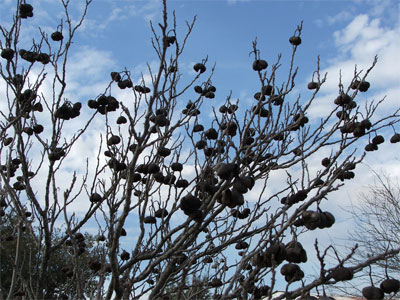
Mexican Buckeye branches laden with capsules
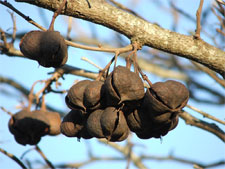
Mexican Buckeye (Ungnadia speciosa) capsules
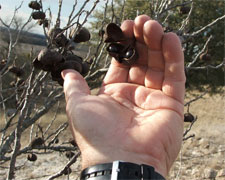
Mexican Buckeye seeds
An especially heavy-capsuled Mexican buckeye (Ungnadia speciosa) causes me to wheel the truck around and take a closer look. Few folks seem to be familiar with this large shrub/small tree, most likely because it flowers at the same time as redbuds in the spring, and folks assume them both to be the same. Far tougher than any redbud in rocky, alkaline soils, Mexican buckeye branches candelabra style to about 15 feet tall and wide, though I have seen taller, thinner individuals. The fragrant, dark-pink flowers are borne in small clusters all along the stems, creating not only a sensational spring floral show, but also a source of quality nectar for bees to produce excellent honey. After flowering, the blossoms develop into intriguing three-celled capsules that hang down off the branches and remain there for a few years, making for easy identification. Initially a beautiful red-tinged green, these inflated capsules eventually harden and turn dark brown as the seeds ripen, creating natural rattles. The hard, round, shiny, brownish-black seeds have a whitish spot on them, which makes them resemble true buckeye seed, but the two plants are not closely related. These seeds were used as marbles by generations of children, and large caches of these seeds have been found in ancient caves and dated to over 9,000 years ago. The seeds are toxic when eaten, so some scientists have concluded they were used for beadwork by the Native Americans. I conclude this as well, because I made a necklace from them back in the 1980s, back when I had the time and inclination to do such things.
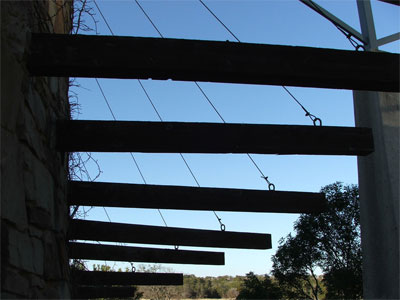
Architecture at the Lady Bird Johnson Wildflower Center
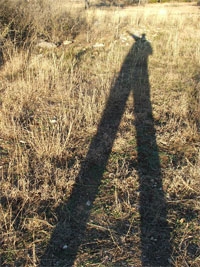
Shadows get long as sunset approaches.
Nowadays, my inclination is to make sure I arrive in Austin during the early afternoon. (Everyone who has experienced that rush-hour traffic is nodding right now.) I make a beeline for the LBJ (that’s Lady Bird Johnson) Wildflower Center to check things out. While most famous for their spring-summer floral meadow montages, the Center’s real ecological message is much larger in scope, ranging from aquifers to atmospheres. The trail system is peppered with outdoor classrooms and interpretation stations that give you the option of a simple stroll or a deep educational immersion. I opt for the latter and fill my brain with fodder not only for the trip home, but hopefully for a lifetime. If you have not experienced this pinnacle of pleasure, this tower of flowers, this meridian of meadows, this cerebral steeple for the people … well, perhaps this is the year to do it. And don’t miss the horticultural heaven that is Zilker Botanical Garden just a few miles away. Great gardens, spectacular stonework, and the friendliest folks in Texas (I’m not kidding) await you. And one more magnificent mention about Austin — it is rapidly becoming the Zenith of Zymurgy. Woo-hoo! (You are just going to have to look that one up!)
A week later, lack of time necessitates I take the freeway to Shreveport. Wow … what a different trip. Blaring classic rock helps to take the edge off as I drive white-knuckled through the DFW Metroplex maelstrom, wedged between eighteen-wheelers at 70 mph. Traffic eases up around Forney, and I am able to peel my clenched fists from the wheel by the time I hit the Piney Woods.
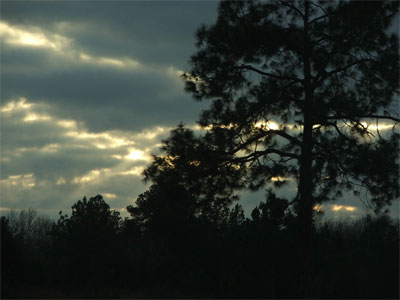
Loblolly Pine (Pinus taeda)
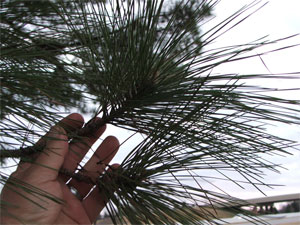
Loblolly Pine (Pinus taeda)
To tell the truth, all these different pines have always been a conundrum for me. I mean, I can get the easy ones — California sugar pine, Coulter pine, Lodgepole pine, Bristlecone Pine, Afghan pine, Japanese black pine — but I have always lacked confidence in ID’ing pines in acid soils, since there are about 100 different species, and all kinds of people plant all kinds of pines in all kinds of places. So, I call my buddy Greg Grant for advice. Not only does he not lambaste me for being ignorant, he actually helps me. Turns out the pine in question is a Loblolly pine (Pinus taeda), the most common forest pine in East Texas, so I guess I really should have known that. I decide that living in alkaline soils for the last 35 years is a pretty good excuse.
In Shreveport, I am bowled over by the enthusiastic, standing-room-only crowd during my talk at the Gardens of the American Rose Center. We laughed, we cried, we learned, and found communion in the wonder and beauty of plants. What was it Roland Brown said … “I don’t know whether nice people tend to grow roses or growing roses makes people nice.” I also like Abraham Lincoln’s take on our national flower: “We can complain that rose bushes have thorns, or rejoice because thorn bushes have roses.”
After the talk, I realize that it is indeed deep winter, and though I stand at the epicenter of 65 gardens containing more than 20,000 roses, there is not a blossom to be found on any of them. Sixty days from now, every color of the rainbow will be painted across these 100-plus acres. Hmmm … think I’ll make some time for a return trip.
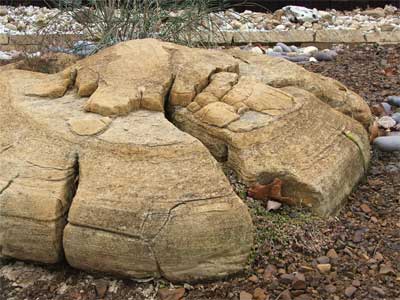
Amazing boulder at the Norton
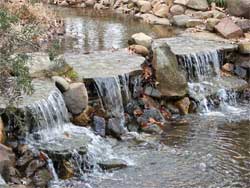
Waterfall at the Norton
In the meantime, a friend of mine takes me a few miles down the road to check out grounds of the R. W. Norton Art Gallery. We stroll across rolling hills under 80-foot tall pines, passing by immense old azalea beds as we go. I get an inkling that this 40-acre garden was planted about as many years ago under pines of about that same height. This part of the garden has a bit of a Capability Brown sense to it: a hugeness that envelops and empowers the few privileged enough to tread here. Recent additions to the garden range from naturalistic to synergistic and from old-boot comfortable to moonscape quirky. Streams ripple cheerily down hillside clefts, converging into a peaceful pond below. Grand bronze sculptures grace apexes and intersections throughout the garden, bringing with them the inevitable emotions and introspection the artist originally sought to convey. In stark contrast to the old, monoculture azalea beds, the new areas are richly and intensively planted with a mosaic of colors and textures. The new additions to the garden surprise and inspire in a way not unlike the way Susan Boyle caught us all off guard the first time she sang into a microphone. All in all, the garden reminds me of a grand dame in a new gown, proud of her past but looking ahead to the future. The Yin and the Yang create harmony once more.
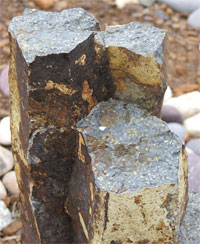
Polygonal basalt

The four dogateers
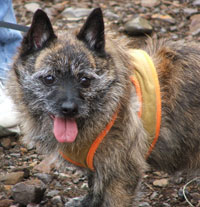
The Blue Huahua
We are leaving the grounds through what can only be described as “the moonscape” (mounds of scree placed mogul style, punctuated by incredible stone specimens–polygonal basalt and the like — with a little path ribboning through it) when we encounter a woman with four tiny dogs straining forward on their leashes. Three of the dogs prove to be unamicable to strangers; the fourth is a veritable fountain of friendliness, a quality that allows me to get up close and personal with him. Not only is he absolutely de-lickty-lightful, but perhaps the most interesting-looking dog I’ve ever met. After some thoughtful rumination, I decide he is a Blue Heeler-Chihuahua mix. A Blue Huahua? A Chi-heeler? You decide….
About the author: Steven Chamblee is the chief horticulturist for Chandor Gardens in Weatherford and a regular contributor to Neil Sperry’s GARDENS magazine and e-gardens newsletter. Steven adds these notes:
What’s new at Chandor Gardens? Most of the 9,600 newly planted bulbs throughout Chandor Gardens are peeking up out of the ground. I am just finishing up the new Pennsylvania bluestone patio, and am on schedule to finish the adjacent Blue Garden. The koi are so happy that many of them are literally leaping from the water! This spring promises to be the most beautiful in decades here at Chandor Gardens. Plan your visit NOW!!! Call 817-613-1700, or visit www.chandorgardens.com for all the details.
I can always use another road trip! Let me know if you’d like me to come out and speak to your group sometime. I’m low-maintenance, flexible, and you know I like to go just about anywhere. No city too big; no town to small. Just send me an e-mail at schamblee@weatherfordtx.gov and we’ll work something out.

